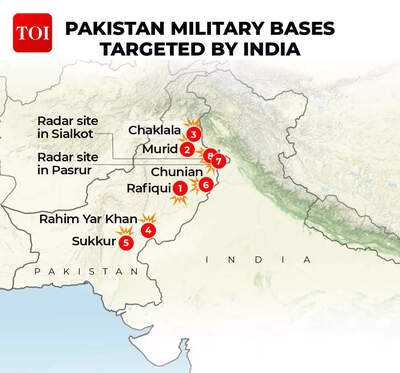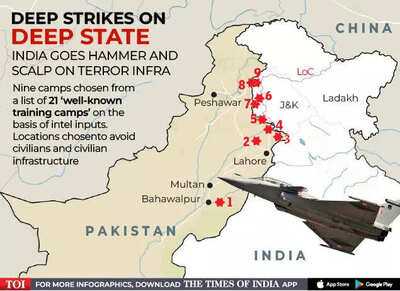NEW DELHI: Indian Air Force Chief Amar Preet Singh on Friday hailed Operation Sindoor , saying that it will be remembered as a conflict that achieved its objectives with speed and precision, and brought Pakistan “to its knees”. Singh said that India struck multiple targets in Pakistan and also destroyed 4-5 Pakistani fighter jets.
Speaking at a press conference on the occasion of the 93rd Air Force Day, he said that the four-day operation was carried out with a clear mandate and ended swiftly because India had accomplished what it set out to do.
Detailing India's offence on Pakistan, the IAF chief said, “As far as Pakistan's losses are concerned...we have struck a large number of their airfields and we struck a large number of installations...Because of these strikes, radars at least four places, command and control centres at two places, runways of course damaged at two places, then three of their hangars in three different stations have been damaged."
"We have signs of one C-130 class of aircraft...and at least 4 to 5 fighter aircraft, most likely F-16, because that place happened to be F-16 with whatever was under maintenance at that time. Along with that, one SAM system has been destroyed...We have clear evidence of one long-range strike, which I talked about more than 300 km, which happened to be either an AEW&C or a significant aircraft, along with that five high-tech fighters between F-16 and JF 17 class this is what our system tells us,” he added.

Singh revealed that India’s newly inducted long-range surface-to-air missiles turned the tables and played a crucial role in crippling Pakistan’s operations.
"Our long-range SAMs that we had procured recently and operationalised...We could look deep inside their territory. We could make sure that they were not able to operate even within their territory up to a certain distance. It will go down in history that longest kill that we achieved of more than 300 kilometres by that. And it seriously curtailed their activities," he said.
Also read: 'Won't show restraint next time': Army chief's big 'geography' warning to Pak - watch
The IAF chief also junked Pakistan's claims about the 4-day conflict calling it, "manohar kahaniyan."
"Their (Pakistan) narrative is 'Manohar Kahaniyan'. Let them be happy, after all, they also have to show something to their audience to save their reputation. That doesn't matter to me." "...If they think they shot down 15 of my jets, let them think about it. I hope they're convinced about it, and they will cater for 15 less aircraft in my inventory when they come to fight again. So why should I talk about it? "
“In the aftermath of the four-day conflict it stands as a lesson; it will go down in history as a war started with a very clear objective and terminated quickly. We called to end the hostilities as a nation because our objectives were achieved. This is something the world needs to learn from us,” he said.

The IAF chief also stressed that the media had played a part in managing the fog of war and cutting down disinformation during the campaign. “We were able to bring them to their knees. Our media handled fog of war very well, cut down disinformation. They stood shoulder-to-shoulder with the Army,” he said.
India carried out Operation Sindoor in response to the Pahalgam terror attack and the Indian Armed Forces hit terror infrastructure in Pakistan and PoJK through precision strikes in May this year. India repelled subsequent escalation by Pakistan and pounded its airbases.
Speaking at a press conference on the occasion of the 93rd Air Force Day, he said that the four-day operation was carried out with a clear mandate and ended swiftly because India had accomplished what it set out to do.
Detailing India's offence on Pakistan, the IAF chief said, “As far as Pakistan's losses are concerned...we have struck a large number of their airfields and we struck a large number of installations...Because of these strikes, radars at least four places, command and control centres at two places, runways of course damaged at two places, then three of their hangars in three different stations have been damaged."
#WATCH | Delhi: On Operation Sindoor, Indian Air Force chief Air Chief Marshal Amar Preet Singh says, "...A clear directive, clear mandate was given to the Indian Armed Forces... It stands as a lesson which will go down in history that this is one war that was started with a… pic.twitter.com/FJuEpFdVQi
— ANI (@ANI) October 3, 2025
"We have signs of one C-130 class of aircraft...and at least 4 to 5 fighter aircraft, most likely F-16, because that place happened to be F-16 with whatever was under maintenance at that time. Along with that, one SAM system has been destroyed...We have clear evidence of one long-range strike, which I talked about more than 300 km, which happened to be either an AEW&C or a significant aircraft, along with that five high-tech fighters between F-16 and JF 17 class this is what our system tells us,” he added.
Singh revealed that India’s newly inducted long-range surface-to-air missiles turned the tables and played a crucial role in crippling Pakistan’s operations.
"Our long-range SAMs that we had procured recently and operationalised...We could look deep inside their territory. We could make sure that they were not able to operate even within their territory up to a certain distance. It will go down in history that longest kill that we achieved of more than 300 kilometres by that. And it seriously curtailed their activities," he said.
Also read: 'Won't show restraint next time': Army chief's big 'geography' warning to Pak - watch
The IAF chief also junked Pakistan's claims about the 4-day conflict calling it, "manohar kahaniyan."
"Their (Pakistan) narrative is 'Manohar Kahaniyan'. Let them be happy, after all, they also have to show something to their audience to save their reputation. That doesn't matter to me." "...If they think they shot down 15 of my jets, let them think about it. I hope they're convinced about it, and they will cater for 15 less aircraft in my inventory when they come to fight again. So why should I talk about it? "
“In the aftermath of the four-day conflict it stands as a lesson; it will go down in history as a war started with a very clear objective and terminated quickly. We called to end the hostilities as a nation because our objectives were achieved. This is something the world needs to learn from us,” he said.
The IAF chief also stressed that the media had played a part in managing the fog of war and cutting down disinformation during the campaign. “We were able to bring them to their knees. Our media handled fog of war very well, cut down disinformation. They stood shoulder-to-shoulder with the Army,” he said.
India carried out Operation Sindoor in response to the Pahalgam terror attack and the Indian Armed Forces hit terror infrastructure in Pakistan and PoJK through precision strikes in May this year. India repelled subsequent escalation by Pakistan and pounded its airbases.
You may also like

Bihar Cabinet hikes DA from 55 to 58 per cent for its employees, pensioners

Over 18 lakh health camps screened 10 crore citizens under Swasth Nari Sashakt Parivar Abhiyaan: Govt

National Council on the Humanities reshuffled: White House fires majority of members; only Trump appointees remain on board

Indian institutes may see less US offers, new bill targets H-1B exemptions for academia

Health Tips - These 8 foods are best for heart health, learn about them.






